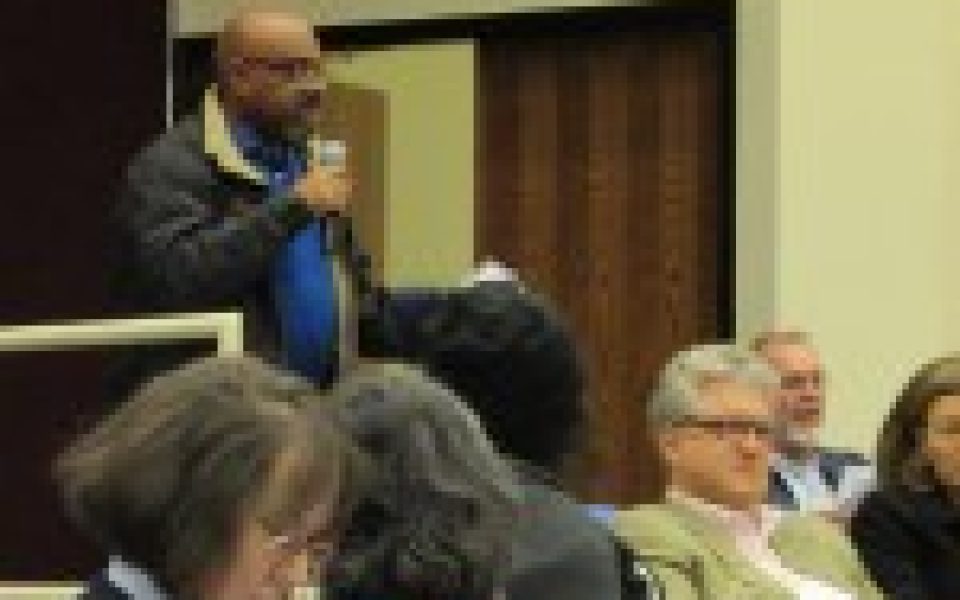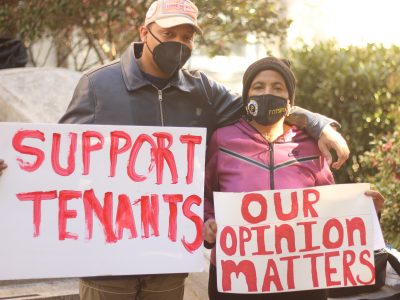by Jordan Green
Urban community leaders in Winston-Salem are disappointed that a proposed $325.8 million school bond doesn’t include more investment in East Winston and other core-city areas.
The replacement of Ashley Academy, an academically struggling, majority black and Latino school located near the low-income La Deara Crest Estates community in Winston-Salem has been dropped from a proposed $325.8 million bond package despite being one of the most overcrowded elementary schools in the district.
The elimination of the project is but one example of what some community leaders, including Winston-Salem NAACP President Ike Howard, see as a failure of the school district to invest in urban-core areas. Howard and others in the Community School Bond Coalition, a group formed last fall representing neighborhood groups across the city, have also expressed disappointment that the Winston-Salem/Forsyth County School Board is not planning to build a new middle school to serve the East Winston neighborhood.
“Once again, it’s the same-old-same-old inequity of resources — the inequity of school locations and inequality of funding to areas in the urban part of the city and black neighborhoods,” Howard said. “If we look around in our communities, we don’t see anything that benefits our community [in the proposed bond referendum]. If we look around our communities we don’t see anything that benefits our community. The vitality of your community is your educational institutions.
“We got umpteenth churches in our black community — got more than we ever had,” Howard continued. “We have a minimum amount of schools. What people have done, even in recruiting businesses and the people that come in with them, the first thing they’re going to ask is, ‘Where are the schools for this neighborhood and what kind of schools are they?’ If there are no schools, you’re going to look elsewhere.”
Ashley Academy is currently 136 students over capacity, even taking into consideration mobile units, according to data provided by the district.
Replacement of Ashley Academy was included in an initial list of projects totaling $552.5 million that staff presented to the school board in July 2015, and as recently as November staff told community leaders they were trying to negotiate a land deal to secure property to build a new school.
“That was something in our long-range plan that the board felt like all the pieces that would need to happen wouldn’t fall into place for it to happen in this construction cycle,” said Chief of Staff Theo Helm, declining to comment on any efforts to secure property for a new school.
“I’m very concerned and highly dismayed that it was left off the school education bond, reason being that the magnet was recently pulled from Ashley,” Howard said. “We felt strongly that the school needed to be included in the bond.”
The district has made no secret of the fact the construction and replacement of six schools, along with additions and renovations to eight others, will still leave many schools relying on mobile units to house classrooms. What happened after the passage of the last school bond, totaling $250 million in 2006, is instructive: The number of mobile units rose from 358 in 2006 to 468 in the current school year. An analysis by Triad City Beat using the districts current enrollment and building capacity numbers found that 6,290 out of 53,633 students, or 11.6 percent, are housed in mobile units or overcrowded in classrooms. With the addition of building capacity for 3,605 students, as outlined in the proposed $325.8 million bond package, 2,685, or 5.0 percent of the currently enrolled students would remain housed in mobile units or overcrowded into classrooms.
Asked what the district plans to do to meet the population needs of Ashley Academy, Helm responded, “Make use of extra space, extra rooms in the building and use mobile units. Where possible, we want to move students from mobile units to brick-and-mortar classrooms. Unfortunately, it’s not the only school in a situation like that.”
Indeed, the proposed bond does not include any projects that would directly address capacity at Kernersville Elementary and Flat Rock Middle School, two suburban schools that are even more overcrowded than Ashley, although the bond includes $1.5 million to purchase land for a future eastern elementary that could relieve Kernersville Elementary.
The most overcrowded middle school is Southeast Middle School in Kernersville, with 208 students over service capacity. The district plans to build a new middle school in the suburban Smith Farms area with a capacity of 800 and at a cost of $27.0 million. Similarly, Jefferson Middle and Meadlowlark Middle on the affluent west side of Winston-Salem are each over service capacity by about 141 and 193 students respectively, and the district plans to build a new school on Robinhood Road at a cost of $27.0 million to house 800 students.
The request by urban community leaders to build a new middle school in East Winston runs into the reality that Winston-Salem Preparatory Academy, the middle school whose attendance area covers the neighborhood, is among a handful of schools that remain under capacity, with only 177 students for 362 seats. Only 77 out of 177 seats at the magnet school, housed in the former Atkins High School — a black institution during the segregation era that dates back to 1931 — are held by students who live in the school’s attendance area. The remaining students are bused out to 10 other middle schools, with suburban East Forsyth Middle and Paisley Middle to the west absorbing the largest numbers.
The urban community leaders argue that lack of investment in schools in the urban core contributes to a vicious cycle of divestment, with families with young children reluctant to purchase homes and elderly people who want to downsize unable to sell their properties, instead hiring property managers to convert formerly owner-occupied dwellings into rentals.
Howard also noted that in the past year the district has closed Hanes Middle School, an urban school on the north side. The school board voted to close the school after concerns about contaminated groundwater were raised and many angry parents withdrew their children. Air-quality test results that came back after the closure revealed that the contamination posed no hazard to students and staff. The district is busing the students across town to the former Hill Middle School in the southeast — an arrangement expected to remain in place for the foreseeable future.
“Instead of increasing schools in East Winston, they’re eliminating them,” Howard said. “There are no viable middle schools in East Winston. That was Hanes. You’re taking the residential kids in that went to Hanes — they stayed on 26th and 27th streets; they went to that school all the way from Piedmont Circle. You’ve taken that school out of the community.”
Some reassurance about the stability of the neighborhood surrounding Winston-Salem Prep is offered in Census data that shows the median value of owner-occupied homes in the Census tract cover the school increased from $60,500 in 2010 to $86,900 in 2014. The fortunes of the Census that encompasses Ashley Academy have more or less stagnated: Housing values dropped from $84,700 to $79,800 over the same period.
In contrast, the Census tract that covers Brunson Elementary in the affluent West End neighborhood, which the district is planning to replace at a cost of of $25.2 million, has seen home values modestly increase from $202,900 to $203,200. The new school will increase capacity from 400 to 800 even though Brunson Elementary is currently 13 students under capacity.
While Ashley Academy and 14 other schools that are over capacity are not being directly addressed under the winnowed bond proposal, the list includes four schools that are under capacity and stand to gain additional classroom capacity. Three out of four — Philo-Hill Magnet Academy, Easton Elementary and Konnoak Elementary — are located on the south side of the city.
Carolyn Highsmith, president of the Konnoak Hills Community Association and a member of the Community School Bond Coalition, publicly thanked the school board during a community meeting last month for keeping the school on the priority list. Under the proposal, the district will partially replace the school, increasing capacity from 400 to 750, at a cost of $19.0 million. Highsmith is currently running for Winston-Salem City Council in the South Ward.
Robert Leak III, president of the Easton Neighborhood Association, expressed dissatisfaction that the plans to invest $9.0 million in additions and a new cafeteria at Easton Elementary won’t be more extensive.
Helm noted that capacity is not the only criteria the district is using the prioritize projects.
Maintenance and upkeep are also factors. That’s why the district proposes to spend $17.0 million to renovate North Forsyth High School, which was built in 1963.
The district also wants to use the bond to help meet three goals — getting 90 percent of third-graders to be able to read at grade level, having 90 percent of high school students graduate in four years and closing the racial achievement gap. Towards that end, the district wants to spend $24.2 million on projectors, interactive tablets and cameras. Helm said the 2006 bond equipped about 1,860 classrooms with technology. The remaining 1,840 classrooms will be updated with technology while the district will refresh technology in the classrooms addressed in the 2006 bond.
Howard, the local NAACP leader, said that while he supports the investments in Konnoak Elementary, Easton Elementary and Philo-Hill Magnet Academy as critical to preventing further student migration to the suburbs, he remains dissatisfied that there are no plans to invest in schools in East Winston.
“You promised us a school for our kids,” he said. “My concern is for East Winston that has no viable schools. You’re talking about spending all this money and you want to keep enhancing the inequality of resources in the schools. It’s nothing good at this point in time that the residents and parents can see that the urban schools and specifically East Winston will get. What do we have to vote for? Nothing. What do we have to support? Nothing. Taxation without representation — that’s what it boils down to.”
Join the First Amendment Society, a membership that goes directly to funding TCB‘s newsroom.
We believe that reporting can save the world.
The TCB First Amendment Society recognizes the vital role of a free, unfettered press with a bundling of local experiences designed to build community, and unique engagements with our newsroom that will help you understand, and shape, local journalism’s critical role in uplifting the people in our cities.
All revenue goes directly into the newsroom as reporters’ salaries and freelance commissions.





This information is quite disturbing, when are we going to wake the hell up and fight for our children and our neighborhood’s. He’ll no not one more new school in any other part of Winston-Salem. They need to tare down Hanes and rebuild it again. Stop unfair bonds, Black lives do matter!